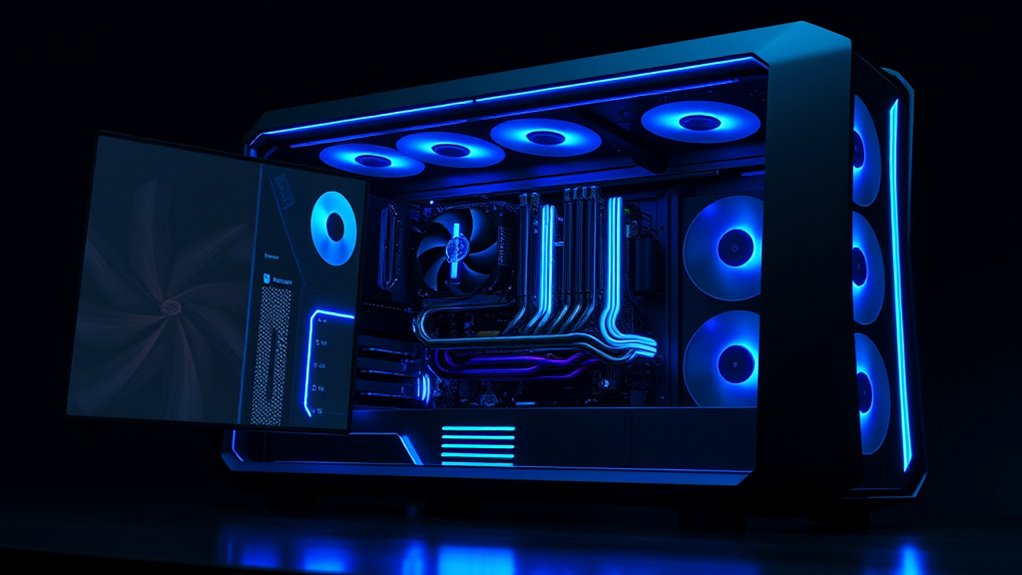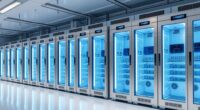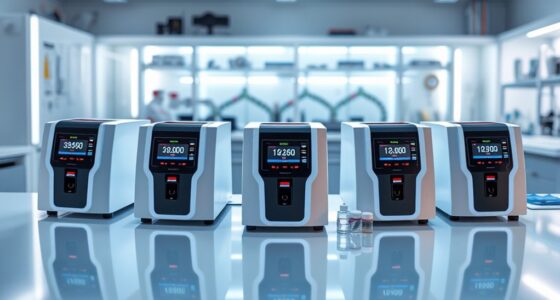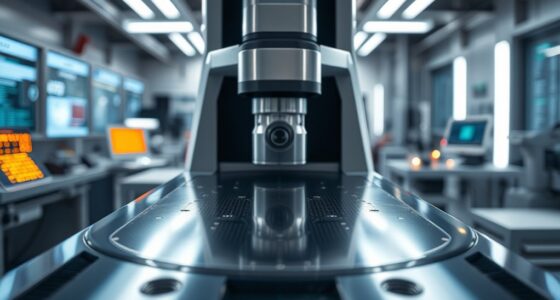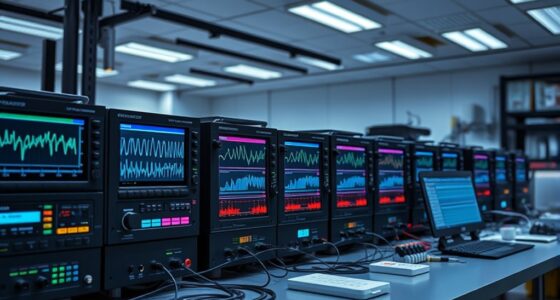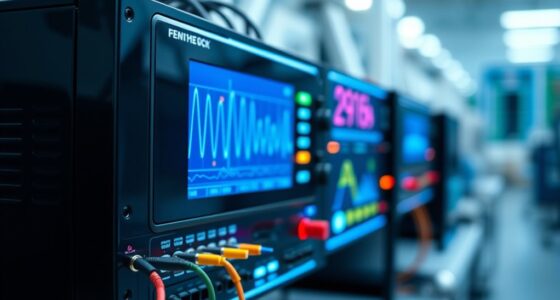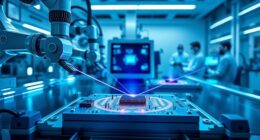If you’re after the best liquid-cooled workstation PC of 2025 for power and efficiency, I recommend the Sentinel Gaming Desktop featuring an AMD Ryzen 7 9800X3D and NVIDIA GeForce RTX 5090. It packs high-end performance, advanced cooling, and ample multitasking capacity into a sleek, high-tech design. This system is built for demanding tasks like gaming, content creation, and VR. Keep going to discover what makes it stand out and how it might fit your needs.
Key Takeaways
- The Sentinel Gaming Desktop features a high-performance AMD Ryzen 7 9800X3D CPU and NVIDIA GeForce RTX 5090 GPU for maximum power.
- Its advanced liquid cooling system ensures optimal thermal management, maintaining efficiency during intensive tasks.
- Equipped with 96GB DDR5 RAM and a 4TB PCIe NVMe SSD, supporting multitasking and fast data access.
- Designed for high-end gaming, content creation, and VR with a focus on power, efficiency, and upgradeability.
- Premium build quality with customizable aesthetic elements, including RGB lighting and polished fittings, enhances visual appeal.
Sentinel Gaming Desktop with GeForce RTX 5090 and Ryzen 7 9800X3D
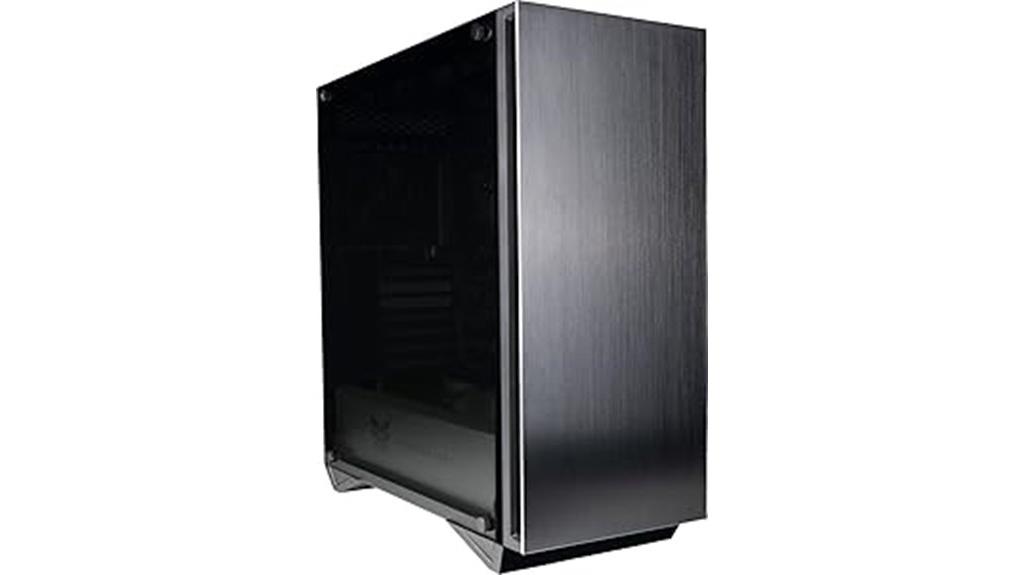
If you’re serious about high-performance gaming or demanding content creation, the Sentinel Gaming Desktop stands out as an ideal choice, especially with its advanced liquid cooling system. It’s powered by the AMD Ryzen 7 9800X3D, with 8 cores, 16 threads, and turbo speeds up to 5.2 GHz, ensuring smooth multitasking and fast processing. The NVIDIA GeForce RTX 5090 with 32GB GDDR7 memory delivers stunning visuals and power efficiency for gaming, VR, and creative work. With 96GB DDR5 RAM and a 4TB PCIe NVMe SSD, it handles heavy workloads effortlessly. This setup guarantees top-tier performance, reliability, and future-proofing for any demanding task.
Best For: serious gamers, content creators, and VR enthusiasts seeking high-performance, future-proof desktop computing.
Pros:
- Exceptional processing power with AMD Ryzen 7 9800X3D and 8 cores, 16 threads
- Advanced graphics with NVIDIA GeForce RTX 5090 and 32GB GDDR7 for stunning visuals
- Ample 96GB DDR5 RAM and 4TB PCIe NVMe SSD for multitasking and fast data transfer
Cons:
- Likely high cost due to top-tier components and premium design
- Large and heavy case may limit space or portability
- Potentially noisy under heavy workloads despite advanced cooling
Factors to Consider When Choosing Liquid‑Cooled Workstation PCS
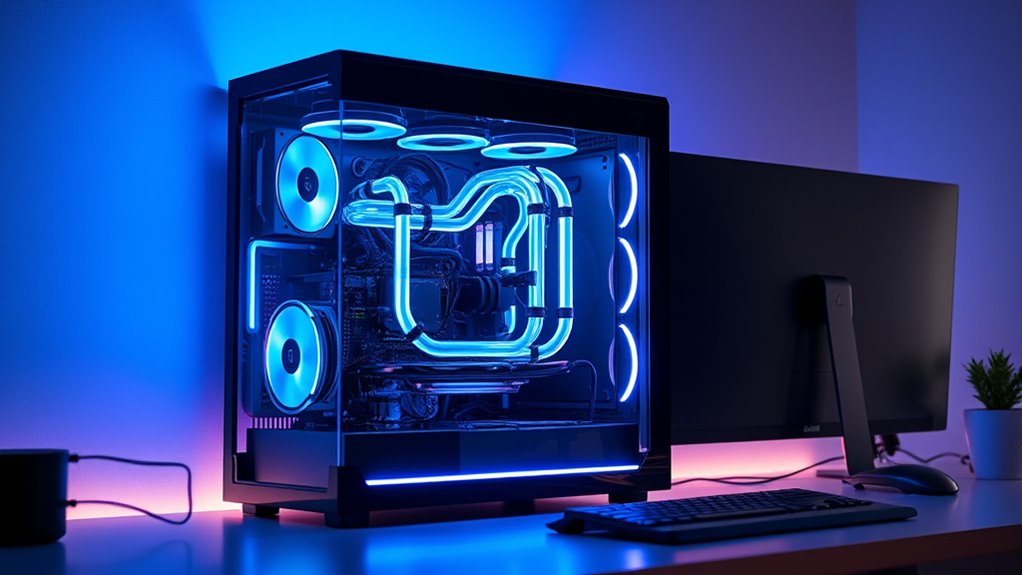
When selecting a liquid-cooled workstation, I look at how well the cooling system matches my hardware’s needs to prevent overheating. I also consider compatibility with my components, noise levels during operation, and how much room there is for future upgrades. Finally, I think about the design’s aesthetics to guarantee it fits my workspace style.
Cooling Efficiency Needs
Choosing the right liquid cooling system hinges on understanding several key factors that influence cooling efficiency. First, I consider the thermal output of my CPU and GPU; high-end components generate significant heat, often requiring custom or advanced liquid cooling solutions for essential performance. Proper coolant flow rate and radiator size are vital—larger radiators and higher flow rates improve heat transfer and maintain consistent temperatures. I also factor in maintenance needs, like coolant replacement and system flushing, to guarantee long-term stability. Enhanced cooling efficiency doesn’t just keep hardware cooler; it also reduces noise, making my workstation quieter during demanding tasks. By matching these variables to my workload, I can maximize cooling performance, extend component lifespan, and maintain peak productivity without sacrificing silence or efficiency.
Hardware Compatibility Checks
Selecting a liquid cooling system isn’t just about performance; it also requires careful attention to hardware compatibility. First, check that your CPU socket and motherboard support the specific pump and radiator sizes you plan to use. This prevents fitting issues during installation. Next, make certain your case has enough space and proper mounting points for the radiator, reservoir, and tubing. Power supply capacity is also critical—confirm it can handle the additional wattage and connectors needed for the pump, fans, and other components. Don’t forget to verify that your GPU and CPU heatsinks are compatible with the chosen cooling blocks for ideal thermal transfer. Lastly, review your case’s clearance and airflow design to avoid obstructing other hardware or airflow paths, ensuring efficient cooling and system stability.
Noise Level Expectations
Liquid-cooled workstations typically run quieter than their air-cooled counterparts because they rely on more efficient heat dissipation, allowing fans to operate at lower speeds. This results in a much quieter environment, often around 20-30 dB at idle, increasing to 40-50 dB under full load. However, the noise level can vary depending on the quality and speed of the pump; high-performance pumps might produce noticeable sound if not properly configured. Modern systems include quiet fans and pumps designed to minimize noise, making them suitable for noise-sensitive settings. Proper maintenance and high-quality components are vital, as degraded parts can increase vibration and sound output. Overall, liquid cooling offers a significant advantage in noise reduction, enhancing comfort and concentration during intensive work.
Upgrade Potential Flexibility
When evaluating liquid-cooled workstations for future upgrades, it’s important to take into account their modular design and component compatibility. Many systems feature easily accessible parts, allowing for straightforward upgrades of CPUs, GPUs, and RAM. The cooling system’s design often provides enough space and standard fittings to support new hardware, making future enhancements simpler. Supporting increased power delivery enables upgrading to higher-performance processors and graphics cards without thermal issues. Compatibility with current and upcoming motherboard chipsets and socket types is also critical to extend the workstation’s lifespan. Clear internal access and standardized fittings facilitate maintenance and upgrades, ensuring the workstation remains flexible over time. Considering these factors helps ensure your investment stays relevant and capable of handling evolving performance demands.
Aesthetic Design Choices
Aesthetic design choices play a pivotal role in shaping the overall look and feel of a liquid-cooled workstation PC. I pay close attention to transparent panels and custom lighting, as they highlight the cooling system’s beauty and craftsmanship. The design of the cooling loops can seamlessly blend into the case’s theme, whether sleek, minimalistic, or high-tech, fitting modern workspaces perfectly. RGB lighting options allow for personalization, matching color schemes or creating dynamic effects that elevate the visual impact. Routing of tubing and placement of radiators are essential for maintaining a clean, organized appearance that aligns with aesthetic goals. Polished fittings, colored coolant, and branded components add a personalized, premium touch, making the workstation not just powerful, but also a striking visual centerpiece.
Frequently Asked Questions
How Often Should I Maintenance My Liquid Cooling System?
I recommend checking your liquid cooling system every three to six months. Keep an eye out for any leaks, discoloration, or buildup of debris in the reservoir and tubes. It’s also a good idea to replace the coolant annually to prevent corrosion and clogging. Regular maintenance guarantees your system runs efficiently and prevents overheating. If you notice any issues, don’t hesitate to flush and refill the system sooner.
Is Liquid Cooling Quieter Than Air Cooling in Workstations?
Absolutely, liquid cooling is whisper-quiet compared to air cooling! I’ve seen even the loudest air-cooled systems sound like jet engines, while liquid cooling keeps my workstation so silent I forget it’s even running. The pump and radiator fans work smoothly, reducing noise to nearly nothing. If you crave a peaceful, noise-free environment for your work, liquid cooling is definitely the way to go—it’s like having a silent partner in your tech setup.
Can I Upgrade Components in a Liquid-Cooled Workstation Easily?
Yes, upgrading components in a liquid-cooled workstation can be straightforward, but it depends on the system’s design. I recommend checking if your setup has accessible reservoirs and easy-to-remove radiators. While some parts like RAM or storage are simple to upgrade, replacing the CPU or GPU may require draining the coolant and removing parts carefully. Always follow manufacturer guidelines to avoid damaging the cooling system.
What Are the Risks of Liquid Cooling Leaks?
Leaking in liquid cooling systems can be a real concern, but with proper setup and maintenance, the risks are minimal. I’ve found that using high-quality components and regularly checking for wear helps prevent leaks. Still, it’s wise to be prepared—having a backup plan and knowing how to shut down your system quickly can save your hardware from damage. Overall, the benefits outweigh the risks if you stay vigilant.
How Does Liquid Cooling Impact Workstation Portability?
Liquid cooling can make a workstation less portable because it adds complexity and weight. The system’s size and the need for secure tubing mean you’re less likely to easily move it around. I find that while liquid cooling offers better performance and quieter operation, it’s best for stationary setups. If portability’s a priority, I’d consider a high-performance air-cooled workstation instead.
Conclusion
So, after all this talk about cooling, noise, and upgrades, you’d think choosing the perfect liquid-cooled workstation would be a breeze, right? Turns out, it’s almost like picking a partner — lots of compromises, a little chaos, and hoping it’ll stay cool under pressure. But hey, if you want power and efficiency in 2025, sometimes you just have to embrace the chaos and trust that your setup will keep its cool—and maybe, just maybe, keep you sane.
